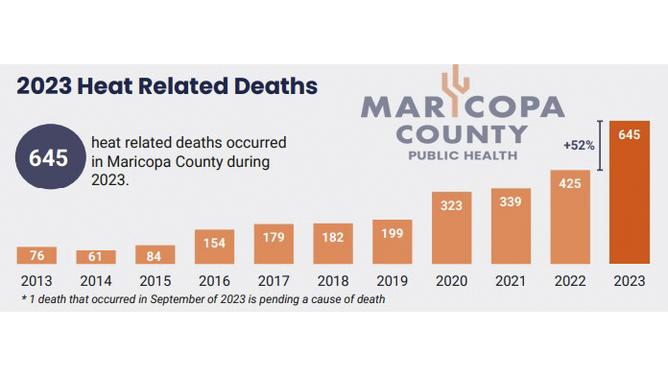US government urged to declare wildfire smoke and extreme heat major disasters
Fourteen state attorney generals are urging the federal government to declare extreme heat and wildfire smoke major disasters. The petition comes as millions of people in the south and north-east face excessive heat advisories, and large swaths of the western US and Canada battle ongoing wildfires.
“The likelihood of high-severity extreme heat and wildfire smoke events is increasing due in part to climate change,” wrote the Arizona attorney general, Kris Mayes, in a letter submitted to the Federal Emergency Management Agency yesterday. “We urge Fema to update its regulations to prepare for this hotter, smokier future.”
Heat-related deaths in Phoenix, Arizona, have nearly doubled this year
The city just had its hottest June on record, with 175 possible heat deaths county-wide so far this year
Phoenix's record summer heat killed over 600 people, new report says
Phoenix's record summer heat killed over 600 people, new report says
Phoenix's summer proved the deadliest on record. Over 50% more people died of heat-related illnesses than during the previous record year, officials said.
--------------------------------------------------------------------------------------------------------------------
|
|
|
Where is heat wave season lasting longer?
Heat wave seasons, defined as the number of days between the first and last heat wave of a year, are growing longer for US cities. In the 1960s, heat wave seasons lasted around 24 days on average. In the 2020s, that number reached 73 days. Early spring or late fall heat waves can be dangerous, as people might be surprised and not adequately prepared.
Among the cities studied by the EPA, San Francisco has had the greatest increase in heat wave season length. On average, heat waves there lasted over three months longer than they did in the 1960s, a 111 day increase. Heat wave seasons also increased by more than 90 days in New Orleans and Tampa, Florida.
Where are heat waves lasting longer?
Not only is heat wave season lengthening, but individual heat waves are also becoming longer. Nationally, an average heat wave has increased from three days long in the 1960s to four days long in the 2010s and 2020s.
New Orleans has had the greatest increase in heat wave length. There, heat waves now last 4.1 days longer on average than in the 1960s. Two other cities — Fort Worth, Texas and Salt Lake City — have had increases in heat wave length by at least three days.
Where are heat waves becoming more intense?
While most of the studied cities have had longer heat wave seasons and longer individual heat waves, one-third of them have had more intense heat waves as well.
The EPA defines the heat wave threshold in each city is the average of the nine hottest days in July and August (the hottest months of the year) from 1981 to 2010. The agency measures heat wave intensity by determining the number of degrees by which the average heat wave surpasses the threshold.
In the 2020s, the average temperature of a heat wave has been 2.3°F above the heat wave threshold for each city. In the 1960s, it was 1.9°F.
Philadelphia has had the biggest increase in heat wave intensity, where heat waves are 1.51 degrees hotter than they were in the 1960s.
Across the country, increases in heat wave length, intensity, and season have made the summers longer and more dangerous.
Explore key facts about the US environment, read more about heat wave frequency, and get the latest data by signing up for our newsletter.








No comments:
Post a Comment